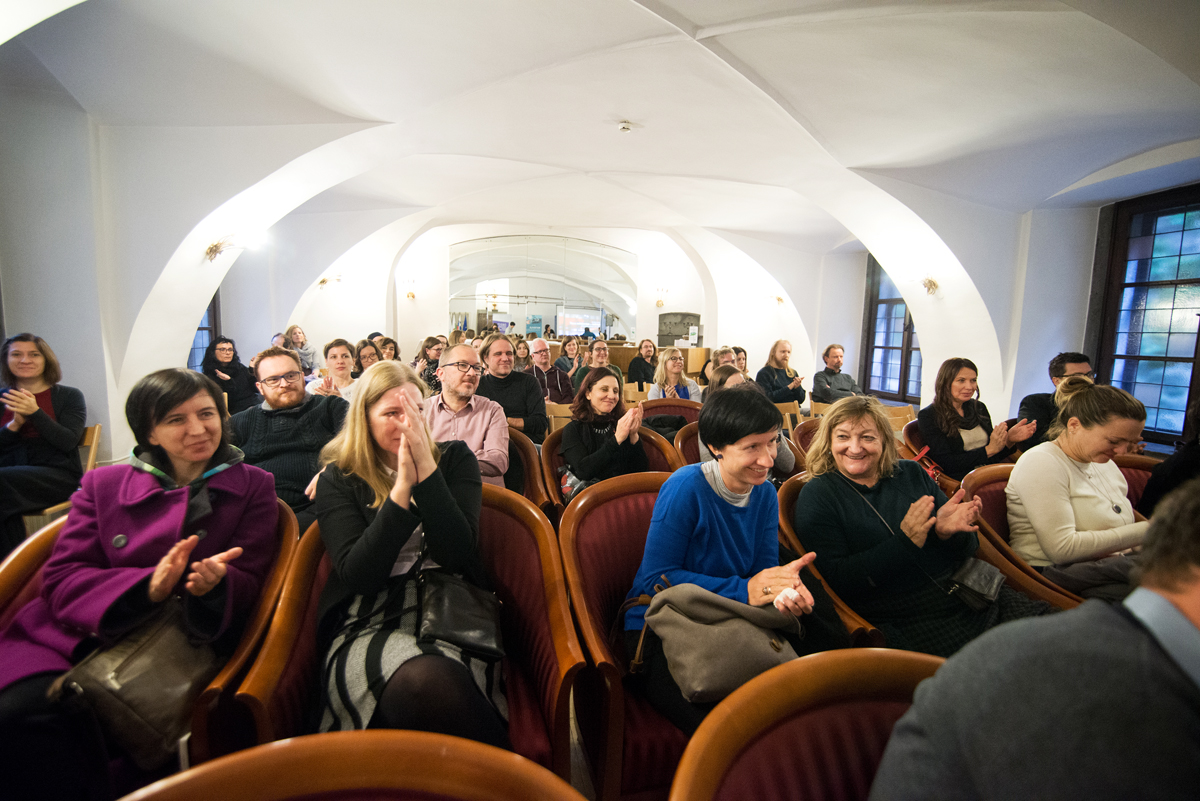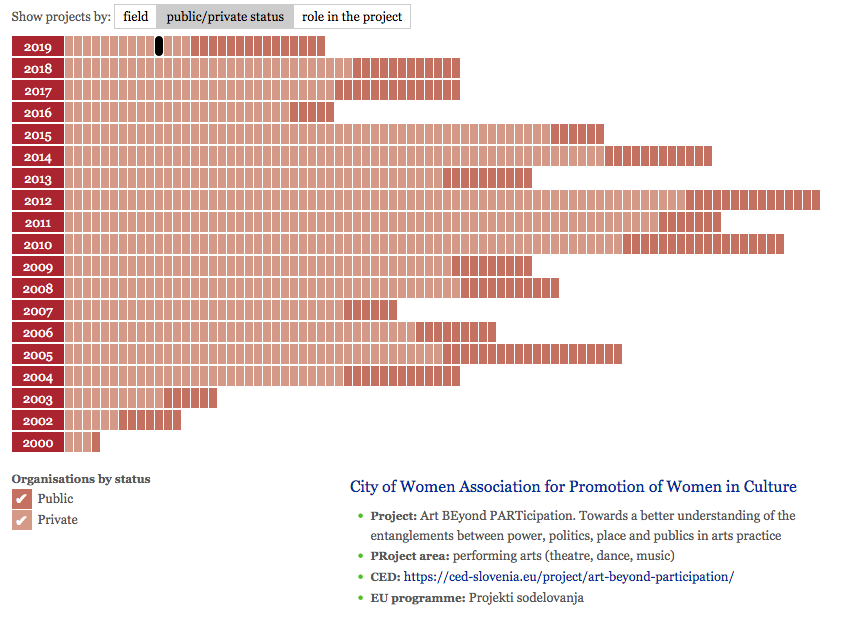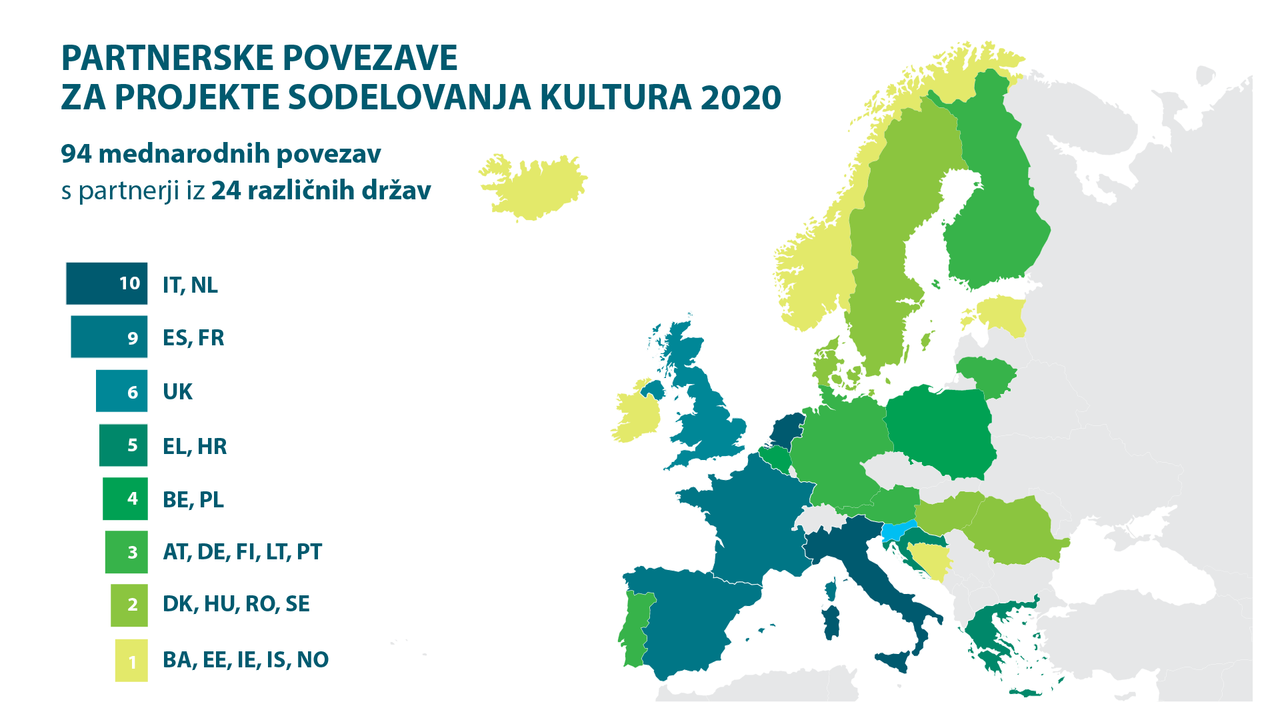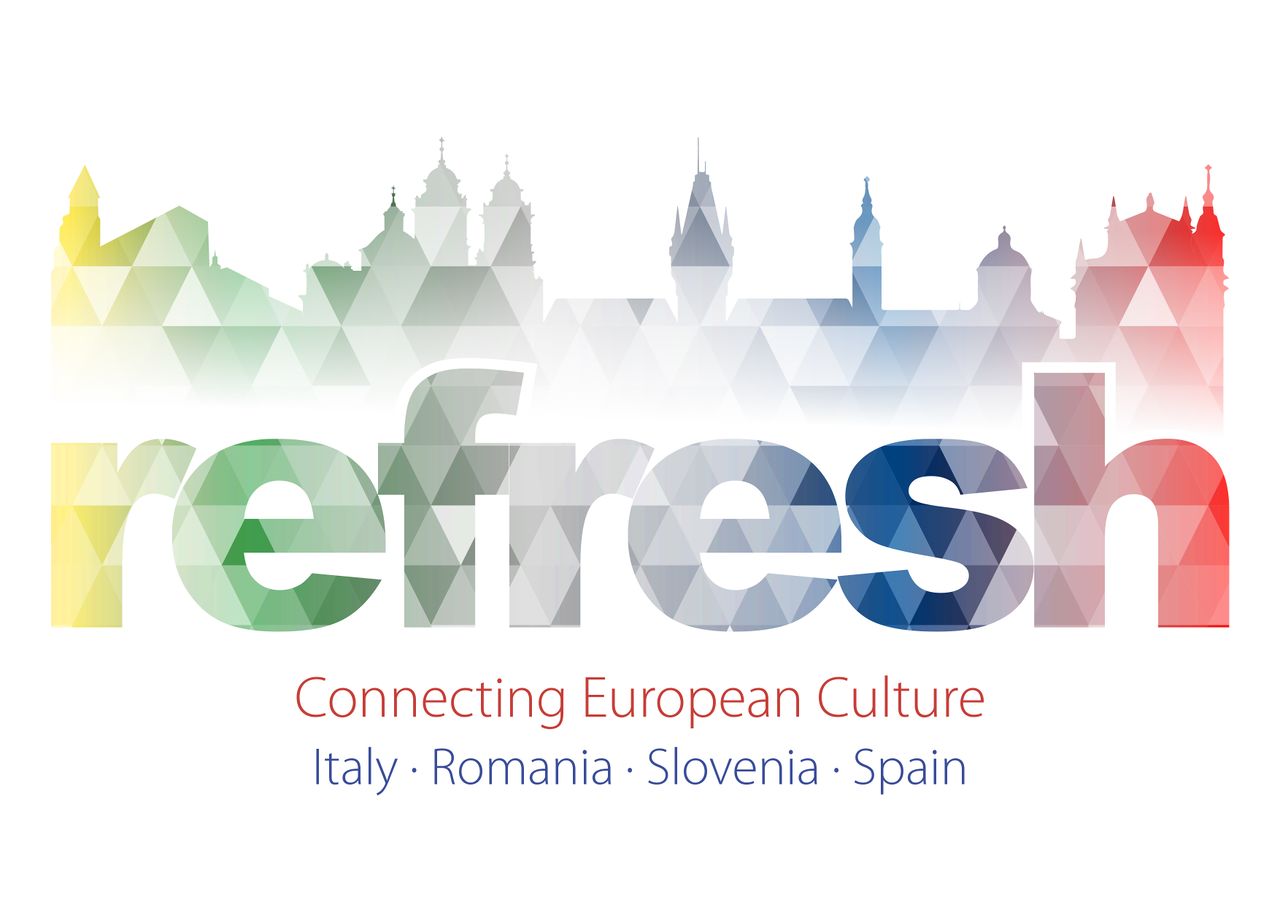Difference between revisions of "Creative Europe in Slovenia"
(link) |
|||
| (3 intermediate revisions by the same user not shown) | |||
| Line 29: | Line 29: | ||
==EU funding illustrated== | ==EU funding illustrated== | ||
| − | The infographic | + | The infographic (unfortunately data are not accessible any more) was based on an interoperability project carried out by [[Culture.si]] and [[Creative Europe Desk Slovenia|CED Slovenia]] / [[Motovila Institute]]. It featured data that relates to EU funding for culture as a whole, encompassing the film and audiovisual media programmes (up until 2014 led under a separate entity known as MEDIA) as well as the two seven-year schemes under the Culture programme (these were preceded by some smaller sector-related programmes from the late 1990s, for which Slovenia was not eligible yet). |
| − | Each square represents one participant organisation. Clicking on a square | + | Each square represents one participant organisation. Clicking on a square takes you to the more in-depth project descriptions. The infographic itself shows the distribution of projects by art field, by the organisation's role in the project and – interestingly – by the organisation's status as either a public or a private entity. |
==Natural-born cultural managers? == | ==Natural-born cultural managers? == | ||
| Line 37: | Line 37: | ||
When analysing the results of the previous years (2007–2011 and 2014–2015), Peter Inkei of the ''Budapest Observatory'' already stated in 2016 that "Slovenia is the incontestable east-central European champion in the Creative Europe programme". Thus his recent statement is merely a reiteration, as he wrote in May 2017, that "the champion is again Slovenia with a 35% success rate". | When analysing the results of the previous years (2007–2011 and 2014–2015), Peter Inkei of the ''Budapest Observatory'' already stated in 2016 that "Slovenia is the incontestable east-central European champion in the Creative Europe programme". Thus his recent statement is merely a reiteration, as he wrote in May 2017, that "the champion is again Slovenia with a 35% success rate". | ||
| − | He is referencing the phenomenal success rate shown in 2017: out of 20 projects with a Slovene "project leader" (the projects are comprised of one lead organisation and several partner ones), 7 managed to be successful in obtaining funds. The other 74 endorsed projects – chosen out of the 548 submitted applications – featured 10 Slovene organisation as partners (which can often be a preferable position in terms of the funding/responsibility trade-off). With all this in mind, Inkei rhetorically wonders if Slovenes are "born cultural managers". They might be, but more probably it is the complex historic composition of the Slovene cultural landscape (especially the NGO scene) that should [https://www.culture.si/en/EU_funding_for_culture_4_observations_from_Slovenia | + | He is referencing the phenomenal success rate shown in 2017: out of 20 projects with a Slovene "project leader" (the projects are comprised of one lead organisation and several partner ones), 7 managed to be successful in obtaining funds. The other 74 endorsed projects – chosen out of the 548 submitted applications – featured 10 Slovene organisation as partners (which can often be a preferable position in terms of the funding/responsibility trade-off). With all this in mind, Inkei rhetorically wonders if Slovenes are "born cultural managers". They might be, but more probably it is the complex historic composition of the Slovene cultural landscape (especially the NGO scene) that should [https://www.culture.si/en/EU_funding_for_culture_4_observations_from_Slovenia offer interesting clues] in this regard. |
{{wide Image|Motovila Institute 2018 Uspesno Ustvarjalno Photo Katja Goljat.jpg}} | {{wide Image|Motovila Institute 2018 Uspesno Ustvarjalno Photo Katja Goljat.jpg}} | ||
| Line 189: | Line 189: | ||
==See also== | ==See also== | ||
* [[Creative Europe Desk Slovenia]] | * [[Creative Europe Desk Slovenia]] | ||
| − | * [[:Category:EU_funding_of_Slovene_organisations_(Culture_and_MEDIA_Programmes)|A list of ALL Slovene organisations | + | * [[:Category:EU_funding_of_Slovene_organisations_(Culture_and_MEDIA_Programmes)|A list of ALL Slovene organisations funded by the Culture and MEDIA Programmes 2000-2020]] |
==External links== | ==External links== | ||
Latest revision as of 23:52, 5 November 2023
Since 1997, hundreds of cultural organisations from across Europe have joined in for a very special set of administrative and discursive protocols. New projects are painstakingly compiled and proposed each year as artists and producers aim for co-funding from one of the European Union's cultural programmes.
Worth about a billion and a half euros and covering the period between 2014 and 2020, Creative Europe is an instrument to support the creation of a shared European cultural space and identity. It is divided into two subprogrammes: the film-focused MEDIA; and the more diverse Culture subprogramme, further partitioned into Literary Translations, European Platforms, European Networks and Cooperation Projects. Slovene cultural producers have been consistently excelling in the latter with considerable panache. In 2020, 18 Slovene organisations are either leaders or partners in 17 out of all 113 supported Cooperation Projects of the Culture subprogramme.
EU funding illustrated
The infographic (unfortunately data are not accessible any more) was based on an interoperability project carried out by Culture.si and CED Slovenia / Motovila Institute. It featured data that relates to EU funding for culture as a whole, encompassing the film and audiovisual media programmes (up until 2014 led under a separate entity known as MEDIA) as well as the two seven-year schemes under the Culture programme (these were preceded by some smaller sector-related programmes from the late 1990s, for which Slovenia was not eligible yet).
Each square represents one participant organisation. Clicking on a square takes you to the more in-depth project descriptions. The infographic itself shows the distribution of projects by art field, by the organisation's role in the project and – interestingly – by the organisation's status as either a public or a private entity.
Natural-born cultural managers?
When analysing the results of the previous years (2007–2011 and 2014–2015), Peter Inkei of the Budapest Observatory already stated in 2016 that "Slovenia is the incontestable east-central European champion in the Creative Europe programme". Thus his recent statement is merely a reiteration, as he wrote in May 2017, that "the champion is again Slovenia with a 35% success rate".
He is referencing the phenomenal success rate shown in 2017: out of 20 projects with a Slovene "project leader" (the projects are comprised of one lead organisation and several partner ones), 7 managed to be successful in obtaining funds. The other 74 endorsed projects – chosen out of the 548 submitted applications – featured 10 Slovene organisation as partners (which can often be a preferable position in terms of the funding/responsibility trade-off). With all this in mind, Inkei rhetorically wonders if Slovenes are "born cultural managers". They might be, but more probably it is the complex historic composition of the Slovene cultural landscape (especially the NGO scene) that should offer interesting clues in this regard.
 Motovila Institute / Creative Europe Desk Slovenia event Uspešno ... Ustvarjalno (Successful ... Creative), hosting Slovenian producers involved in the Creative Europe funding scheme, 2018.
Motovila Institute / Creative Europe Desk Slovenia event Uspešno ... Ustvarjalno (Successful ... Creative), hosting Slovenian producers involved in the Creative Europe funding scheme, 2018.
Input of the Creative Europe Desk Slovenia (Motovila Institute)
There is, however, one factor that seems to stand out as rather important – the Creative Europe Desk Slovenia. This is the national information office for such matters, led by the small, but dedicated and trusted, NGO Motovila Institute. Recently, its crew, in a telling phrase that further elaborates Inkei's remark, has been labelled by one of the grant-winning producers as "our mothers".
Be that as it may, helping out the applicants with advice, conducting informative workshops and carrying out other matters of general support, Motovila team sports a systematic approach towards producing a community-based pool of skills, tricks, contacts and the like.
In any case, 2018, 2019 and 2020 brought excellent results again.
Recent Culture Cooperation Project recipients
The chosen propositions from Slovenia are of course very diverse. One would be hard-pressed to find a common theme even as the wordings of project descriptions tend to be somewhat generic, their authors striving to align them with the supposed affinities of Brussels.
The composition of successful organisations is similarly miscellaneous, ranging from small organisations to big and venerated art producers. While 6 of the participating organisations haven't had any prior experience in EU's cultural programmes, 14 of them are veterans with at least one project under their belts. If, in 2017, the public institutions significantly boosted their Creative Europe profile, and almost caught up with the previously much more industrious NGO sector, also in 2018, out of 18 organisations there were 8 successful public institutions.
 Online version (printscreen) of interactive EU funding infographic, featuring successful producers with public or private status, recipients of EU Funding 2000-2019 (Culture and Media). Data have been collected by Motovila Institute that operates the Creative Europe Desk Slovenia
Online version (printscreen) of interactive EU funding infographic, featuring successful producers with public or private status, recipients of EU Funding 2000-2019 (Culture and Media). Data have been collected by Motovila Institute that operates the Creative Europe Desk Slovenia
In 2019, the number of successful public institutions (13) was even a bit higher than the number of NGO organisations (12). The 3 producers that got the grant as lead organisations are involved as partners in another granted Cooperation Projects. The producers located in Ljubljana, Maribor, Nova Gorica, Novo mesto and Murska Sobota collaborate mostly with partners from Italy (15), Germany (12), Belgium (11), UK (11), and Poland (10).
In 2020, the number of successful NGO organisations (10) and public institutions (8) is almost equal, they have their seats in Ljubljana, Škofja Loka and Kranj. All partners cooperate with 94 organisations from 24 countries, mostly with the Dutch, Italian, Spanish, French, British and Greek partners.
 The infographic featuring the international impact of 18 successful producers from Slovenia who have received the Creative Europe funds in 2020 for cooperation with 94 partners from 24 countries! Prepared by Motovila Institute that operates the Creative Europe Desk Slovenia.
The infographic featuring the international impact of 18 successful producers from Slovenia who have received the Creative Europe funds in 2020 for cooperation with 94 partners from 24 countries! Prepared by Motovila Institute that operates the Creative Europe Desk Slovenia.
Cultural Cooperation Projects in the Western Balkans
The 2020 call strengthening cultural cooperation with and the competiveness of cultural and creative industries in the Western Balkans resulted in 320 project proposals. The EACEA selected 13 projects for support, among them one project with a Slovenian leader (Pazi!Park Association), while 7 Slovenian partner organisations are involved in another 6 successful projects. The Western Balkans call resulted in many new connections for Slovenian organisations with partners from Albania, Bosnia and Hercegovina, Croatia, Kosovo, Macedonia, Montenegro and Serbia. See the list of organisations below.
2020 Cultural Cooperation Projects in the Western Balkans recipients
- Pazi!Park Association (lead)
- Festival Ljubljana Public Institute (partner)
- Nomad Dance Academy Slovenia (partner)
- Lokar Gallery (partner)
- Asociacija, Association of Arts and Culture NGOs and Freelancers (partner)
- Studio for Research into the Art of Acting (partner)
- Museum and Galleries of Ljubljana (partner)
- Navipro (partner)
2020 recipients
- Exodos Institute (lead)
- Slovene Association of Historic Towns (lead)
- Ljubljana Puppet Theatre (lead)
- Radio-Television Slovenia (RTV Slovenia) (lead)
- International Centre of Graphic Arts, Ljubljana (partner)
- Ljudmila Art and Science Laboratory (partner)
- Public Fund for Cultural Activities of the Republic of Slovenia (partner)
- Kersnikova Institute (partner)
- Beletrina Publishing Institute (partner)
- National Museum of Contemporary History (partner)
- ProstoRož (partner)
- Kranj City Library partner)
- Nomad Dance Academy Slovenia (partner)
- Bunker Institute (partner)
- Urban Planning Institute of the Republic of Slovenia (partner)
- City of Women Association for Promotion of Women in Culture (partner)
- Druga godba Ljubljana (partner)
- Jožef Stefan Institute (partner)
2019 recipients
- City of Women Association for Promotion of Women in Culture (lead and partner)
- Pionirski dom Youth Culture Centre (lead and partner)
- Radio Študent (RŠ) (lead)
- Slovenian Theatre Institute (lead)
- Goga Publishing House (lead and partner)
- National Museum of Contemporary History (partner)
- Ljubljana Puppet Theatre (partner in 2 projects)
- Bunker Institute (partner)
- SIGIC, Slovene Music Information Centre (partner)
- Slovene Ethnographic Museum (partner)
- National and University Library (partner)
- Rakičan Mansion Research and Education Centre (partner)
- Public Fund for Cultural Activities of the Republic of Slovenia (partner)
- Slovenian Book Agency (partner)
- Kersnikova Institute (partner)
- Slovene Writers’ Association (partner)
- Association for Contemporary Arts X-OP (partner)
- SCCA-Ljubljana Centre for Contemporary Arts (partner)
- Projekt Atol Institute (partner)
- Maribor Art Gallery (partner)
- University of Ljubljana (partner)
- University of Nova Gorica (partner)
- Young Dragons Public Institute (partner)
- TiPovej Institute (partner)
- Cona Institute (partner)
2018 recipients
- Bunker Institute (lead and partner))
- Imago Sloveniae (lead)
- Projekt Atol Institute (lead)
- Slovene Association of Historic Towns (lead)
- Slovene Writers’ Association (lead and partner)
- Dance Theatre Ljubljana (partner)
- Glej Theatre (partner)
- City of Women Association for Promotion of Women in Culture (partner)
- Druga godba Ljubljana (partner)
- International Centre of Graphic Arts, Ljubljana (partner)
- Kersnikova Institute (partner)
- Ljubljana Puppet Theatre (partner)
- Moderna galerija / Museum of Modern Art, Ljubljana plus Museum of Contemporary Art Metelkova (partner)
- Municipality of Piran-Pirano (partner)
- Museum of Architecture and Design (partner)
- Nomad Dance Academy Slovenia (partner)
- Slovene National Theatre Maribor (partner)
- Slovene National Theatre Nova Gorica (partner)
- Scientific Research Centre (ZRC SAZU), Slovene Academy of Science and Arts (partner)
- Walk of Peace in the Soča Region Foundation (partner)
 The logotype of the REFRESH cooperation project related to the European Year of Cultural Heritage 2018, led by Slovene Association of Historic Towns, supported by Creative Europe
The logotype of the REFRESH cooperation project related to the European Year of Cultural Heritage 2018, led by Slovene Association of Historic Towns, supported by Creative Europe
The REFRESH cooperation project led by Slovene Association of Historic Towns got the Creative Europe support related to the European Year of Cultural Heritage 2018.
2017 recipients
- Aksioma Institute (lead)
- Goga Publishing House (lead)
- House! Society for People and Spaces (lead)
- Moderna galerija / Museum of Modern Art, Ljubljana plus Museum of Contemporary Art Metelkova (lead)
- MoTA Museum of Transitory Art (lead)
- Pionirski dom Youth Culture Centre (lead)
- Sodobnost International Cultural Society (lead)
- City of Women Association for Promotion of Women in Culture
- Federacija Institute
- Gallus Foundation
- Institute for the Protection of Cultural Heritage of Slovenia
- Department of Art History, University of Ljubljana
- Kino Šiška Centre for Urban Culture
- Ljubljana Puppet Theatre
- Ljudmila Art and Science Laboratory
- Maribor Art Gallery
- Technical Museum of Slovenia
European platforms
Literary translation scheme
See also
- Creative Europe Desk Slovenia
- A list of ALL Slovene organisations funded by the Culture and MEDIA Programmes 2000-2020
External links
- April 2017 news from the Budapest Observatory, commenting on the Creative Europe Collaboration Projects 2017 results
- May 2016 news from the Budapest Observatory, also commenting on the Creative Europe Collaboration Projects 2016 results
- "The Story of 751 Bonds", a research paper on partnerships in EU-financed cultural projects, 2007-2011 and 2014-2015
- EU funding for culture? 4 observations from Slovenia, a blog post by Culture.si and Creative Europe Desk Slovenia in 2014
 <small class="imgdesc">The infographic featuring the international impact of 18 successful producers from Slovenia who have received the Creative Europe funds in 2020 for cooperation with 94 partners from 24 countries!ration with 94 partners from 24 countries! +
<small class="imgdesc">The infographic featuring the international impact of 18 successful producers from Slovenia who have received the Creative Europe funds in 2020 for cooperation with 94 partners from 24 countries!ration with 94 partners from 24 countries! +

